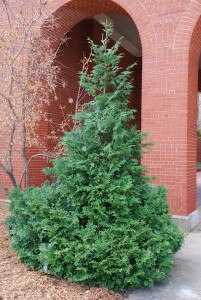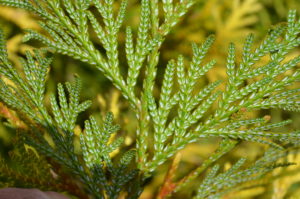Hiba or false arborvitae (Thujopsis dolobrata) is a slow to moderate growing evergreen shrub or tree. It is also called elkhorn cedar and deerhorn cedar, referring to the shape of its scale-like leaves. Tall 50-80 feet tall tree forms arefound in the forests of Japan.
This native of Japan and China has a pyramidal form and beautiful dense foliage, similar to arbovitae (Thuja spp.). The scale-like bright or dark green leaves are arranged in flattened sprays with white markings beneath. Its reddish-brown peeling bark adds to the plant’s appeal. Small 3/4 inch cones provide little ornamental value. A notable tree form occasionally available from U.S. nurseries is ‘Hondai’; it grows much shorter at 30 – 35 feet in height with dense sprays of dark green foliage.
False arborvitae grows best on a moist well-drained site in full sun or bright shade . Occasional watering is recommended in severe summer/fall dry periods. False arborvitae needs to be sheltered from dry winter winds.
Winter foliage color may vary by location and cultivar planted. In Southern Appalachian Region (USDA zones 6 and 7), winter foliage takes on a muted olive-green tone.
Two most popular dwarf clones are:
- ‘Aurea’ – a dense shrub with golden yellow foliage; grow in light shade.
- ‘Nana’ – a slow growing, dwarf mounding form with good plant symmetry; its wintry foliage takes on a silvery tint.
A 10-year old ‘Aurea’ or ‘Nana’ thujopsis grows 3 to 4 feet tall and 5 to 6 feet wide.
False arborvitae is hard to find in the nursery trade, available thru e-commerce specialty nurseries.



 Posted in
Posted in 
